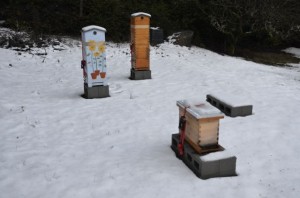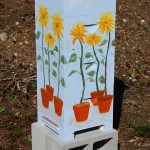Short answer: Bees use different phenomena to fly than a plane does – translational, rotational, acceleration-reaction, and wing-wake interaction forces produced by the flapping of their wings.
Longer answer:
Most insects are thought to fly by creating a leading-edge vortex that
remains attached to the wing throughout a relatively slow, long stroke, bees do not follow this model.
The secret of bees ability to fly is a combination of short, choppy wing strokes, a rapid rotation of the wing as it reverses direction, and a very fast wing-beat frequency (230 beats per second).
This is the result:

The top red/blue lines show the wings going up and down, the middle lines show the angle of attack of the wings (basically vertical on the way up, and horizontal on the way down) This movement creates lift (the black line) greater than drag (green line) almost all the way through the stroke.
And as lift > drag, the bee flies (yay!)
The mechanisms by which the bee is generating lift are thought to be translational, rotational, acceleration-reaction, and wing-wake interaction forces. However, because of the way the forces scale with velocity, and acceleration, the contribution of the non-translational forces is greater for
shorter amplitude strokes .
This is very different to other insects where the lift is predominately translational at mid-stroke. This gives us the reason other insects seem to be ‘theoretically’ able to fly whilst the bee can’t. The other insects lift mechanism is better approximated by the aerodynamics of an unmoving wing.
The scientist who investigated (Michael Dickinson, an insect flight expert at Caltech) stated:
It is the more exotic forces created as the wing changes direction that
dominate, Additional vortices are produced by the rotation of the wing. It’s like a propeller, where the blade is rotating too. Also, the wing flaps back into its own wake, which leads to higher forces than flapping in still air. Lastly, there is another peculiar force known as “added-mass force” which peaks at the ends of each stroke and is related to acceleration as the wings’ direction changes.
Answer summarised from the paper available here:
http://www.ncbi.nlm.nih.gov/pmc/…



